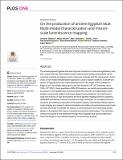| dc.contributor.author | Seymour, Linda Marie | |
| dc.contributor.author | Nicola, M | |
| dc.contributor.author | Kessler, Max | |
| dc.contributor.author | Yost, Claire | |
| dc.contributor.author | Bazzacco, A | |
| dc.contributor.author | Marello, A | |
| dc.contributor.author | Ferraris, E | |
| dc.contributor.author | Gobetto, R | |
| dc.contributor.author | Masic, Admir | |
| dc.date.accessioned | 2021-02-09T19:53:07Z | |
| dc.date.available | 2021-02-09T19:53:07Z | |
| dc.date.issued | 2020-11 | |
| dc.date.submitted | 2020-08 | |
| dc.identifier.issn | 1932-6203 | |
| dc.identifier.uri | https://hdl.handle.net/1721.1/129725 | |
| dc.description.abstract | This is an open access article distributed under the terms of the Creative Commons Attribution License, which permits unrestricted use, distribution, and reproduction in any medium, provided the original author and source are credited. The ancient pigment Egyptian blue has long been studied for its historical significance; however, recent work has shown that its unique visible induced luminescent property can be used both to identify the pigment and to inspire new materials with this characteristic. In this study, a multi-modal characterization approach is used to explore variations in ancient production of Egyptian blue from shabti statuettes found in the village of Deir el-Medina in Egypt (Luxor, West Bank) dating back to the New Kingdom (18th-20th Dynasties; about 1550-1077 BCE). Using quantitative SEM-EDS analysis, we identify two possible production groups of the Egyptian blue and demonstrate the presence of multiple phases within samples using cluster analysis and ternary diagram representations. Using both macroscale non-invasive (X-rays fluorescence and multi-spectral imaging) and micro-sampling (SEM-EDS and Raman confocal microspectroscopy) techniques, we correlate photoluminescence and chemical composition of the ancient samples. We introduce Raman spectroscopic imaging as a means to capture simultaneously visible-induced luminesce and crystal structure and utilize it to identify two classes of luminescing and non-luminescing silicate phases in the pigment that may be connected to production technologies. The results presented here provide a new framework through which Egyptian blue can be studied and inform the design of new materials based on its luminescent property. | en_US |
| dc.language.iso | en | |
| dc.publisher | Public Library of Science (PLoS) | en_US |
| dc.relation.isversionof | http://dx.doi.org/10.1371/journal.pone.0242549 | en_US |
| dc.rights | Creative Commons Attribution 4.0 International license | en_US |
| dc.rights.uri | https://creativecommons.org/licenses/by/4.0/ | en_US |
| dc.source | PLoS | en_US |
| dc.title | On the production of ancient Egyptian blue: Multi-modal characterization and micronscale luminescence mapping | en_US |
| dc.type | Article | en_US |
| dc.identifier.citation | Seymour, Linda M. et al. "On the production of ancient Egyptian blue: Multi-modal characterization and micronscale luminescence mapping." PLoS ONE 15, 11 (November 2020): e0242549 © 2020 Seymour et al. | en_US |
| dc.contributor.department | Massachusetts Institute of Technology. Department of Civil and Environmental Engineering | en_US |
| dc.relation.journal | PLoS ONE | en_US |
| dc.eprint.version | Final published version | en_US |
| dc.type.uri | http://purl.org/eprint/type/JournalArticle | en_US |
| eprint.status | http://purl.org/eprint/status/PeerReviewed | en_US |
| dc.date.updated | 2021-02-04T18:22:37Z | |
| dspace.orderedauthors | Seymour, LM; Nicola, M; Kessler, MI; Yost, CL; Bazzacco, A; Marello, A; Ferraris, E; Gobetto, R; Masic, A | en_US |
| dspace.date.submission | 2021-02-04T18:22:41Z | |
| mit.journal.volume | 15 | en_US |
| mit.journal.issue | 11 | en_US |
| mit.license | PUBLISHER_CC | |
| mit.metadata.status | Complete | |
